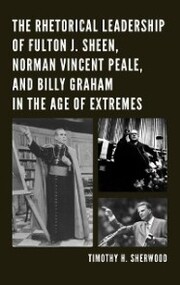Detailansicht
The Rhetorical Leadership of Fulton J. Sheen, Norman Vincent Peale, and Billy Graham in the Age of Extremes
eBook
ISBN/EAN: 9780739174319
Umbreit-Nr.: 2156979
Sprache:
Englisch
Umfang: 194 S.
Format in cm:
Einband:
Keine Angabe
Erschienen am 15.08.2013
Auflage: 1/2013
E-Book
Format: EPUB
DRM: Adobe DRM
€ 57,95
(inklusive MwSt.)
Sofort Lieferbar
- Zusatztext
- Fulton J. Sheen, Norman Vincent Peale, and Billy Graham were Americas most popular religious leaders during the mid-twentieth century period known as the golden years of the Age of Extremes. It was part of an era that encompassed polemic contrasts of good and evil on the world stage in political philosophies and international relations. The 1950s and early 1960s, in particular, were years of high anxiety, competing ideologies, and hero/villain mania in America. Sheen was the voice of reason who spoke against those conflicting ideologies which were hostile to religious faith and democracy; Peale preached the gospel of reassurance, self-assurance, and success despite ominous global threats; and Graham was the heroic model of faith whose message of conversion provided Americans an identity and direction opposite to atheistic communism. This study looks at how and why their rhetorical leadership, both separately and together, contributed to the climate of an extreme era and influenced a national religious revival.
- Kurztext
- This study looks at Fulton J. Sheen, Norman Vincent Peale, and Billy Graham and how and why their rhetorical leadership, both separately and together, contributed to the climate of an extreme era and influenced a national religious revival.
- Autorenportrait
- Fulton J. Sheen, Norman Vincent Peale, and Billy Graham were America¿s most popular religious leaders during a period within the Age of Extremes, specifically the 1950s and early 1960s, when America¿s world view reflected a polarity consensus of good and evil. This critical study seeks to understand how and why their rhetorical leadership, both separately and together, contributed to the climate of an extreme era and influenced a national religious revival.
